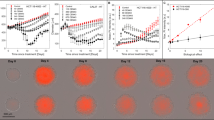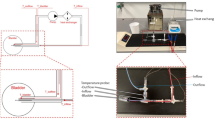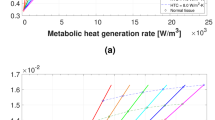Abstract
Thermosensitisation by step-down heating (SDH) has previously been demonstrated in experimental rodent tumours. The purpose of the study reported here was to investigate whether the SDH effect in tumours in part may be attributed to heat-induced alterations in the capillary network and/or the microenvironment. Two human melanoma xenograft lines differing substantially in vascular parameters were selected for the study. A thermostatically regulated water bath was used for heat treatment. The conditioning treatment (44.5 degrees C or 45.5 degrees C for 15 min) was given in vivo, whereas the test treatment (42.0 degrees C for 45, 90, 135 or 180 min) was given either in vitro or in vivo. Treatment response was measured in vitro using a cell clonogenicity assay. Fraction of occluded vessels following heat treatment was assessed by examination of histological sections from tumours whose vascular network was filled with a contrast agent. Tumour bioenergetic status and tumour pH were measured by 31P magnetic resonance spectroscopy. The conditioning heat treatments caused significant vessel occlusion, decreased tumour bioenergetic status and decreased tumour pH in both tumour lines. The SDH effect measured when the test treatment was given in vivo was significantly increased relative to that measured when the test treatment was given in vitro. The magnitude of the increase showed a close relationship to fraction of occluded vessels, tumour bioenergetic status and tumour pH measured 90 min after treatment with 44.5 degrees C or 45.5 degrees C for 15 min. The increased SDH effect in vivo was probably attributable to tumour cells that were heat sensitive owing to the induction of low nutritional status and pH during the conditioning treatment. Consequently, the SDH effect in some tumours may in part be due to heat-induced alterations in the microenvironment. This suggests that SDH may be exploited clinically to achieve increased cell inactivation in tumours relative to the surrounding normal tissues.
This is a preview of subscription content, access via your institution
Access options
Subscribe to this journal
Receive 24 print issues and online access
$259.00 per year
only $10.79 per issue
Buy this article
- Purchase on Springer Link
- Instant access to full article PDF
Prices may be subject to local taxes which are calculated during checkout
Similar content being viewed by others
Author information
Authors and Affiliations
Rights and permissions
About this article
Cite this article
Rofstad, E. Step-down heating of human melanoma xenografts: effects of the tumour microenvironment. Br J Cancer 70, 453–458 (1994). https://doi.org/10.1038/bjc.1994.327
Issue Date:
DOI: https://doi.org/10.1038/bjc.1994.327
This article is cited by
-
A history of exploring cancer in context
Nature Reviews Cancer (2018)



